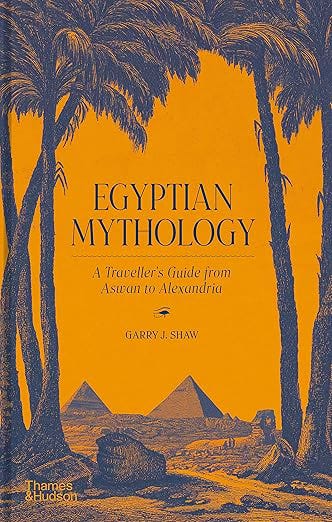Alberta Review: Egyptian Mythology
A review of a decent book, and a big stretch to relate it to Alberta
The best and fastest way for this to grow is for you to share the posts within your networks. A forward goes a long way, and the more subscribers we get, the more I’ll be able to write. The writing may change in the next few months to be a bit more entertaining (we hope) so tell your friends!
Travel writing is the most alluring, but likely the hardest to pull off. At its worst, it’s paid advertising, but at its best, it is beautiful and inspiring, and is about more than a location, but the people who make it special. Popular history, too, is a hard genre to pull off; if it’s a narrative, it risks being a timeline with filler words in between. If it is too much in the weeds, the importance of the topic can be lost. Combining the two, then, is a tricky task, one that is attempted in Egyptian Mythology: A Traveller’s Guide from Aswan to Alexandria.
The book follows the Nile from south to north, putting the ancient tourist attractions along the way into their religious context. So, in that sense, it’s less historical and more theological and sociological. It explains the vagaries of the Egyptian pantheon, including the contradictory stories that make up the ancient civilization’s mythos and the people who built the sites. It’s not an easy task, as the author, Garry Shaw, notes: “Remember, if the past is another country, mythology is another world.”
It's an informative book, but it leaves one with a love of history a bit wanting; the theological context is prominent, but the political and historical bits are sparse. The focus on one of the world’s most important and prominent rivers is essential, but the role of the river in forming religious beliefs is little remarked upon.
Throughout, I couldn’t help but think about the river, which seems to be just a backdrop to the stories being told. The Nile is the reason for Egypt, both of the ancient and modern varieties. I tend to take a geographical view of most things, and use it as my jumping off point when doing any sort of analytical undertaking, but in a place like Egypt, with a river like the Nile, even a non-river-obsessive has to put it front and centre. Rivers drive politics, economics, and culture like few other prominent features can.
The role of Alberta’s rivers in our history is too often overshadowed by other things, mainly oil and gas. There are the obvious bits, like the North Saskatchewan and Athabasca facilitating the fur trade, the Bow, South Saskatchewan, and Milk irrigating our crops. But there’s also the Battle River, which has acted as a dividing line for generations, playing a role in our politics before we had politics. As Harvey Locke wrote in the Literary Review of Canada in 2014:
There are, in fact, two very distinct regions in Alberta dominated by Calgary and Edmonton. The dividing line is the aptly named Battle River…It demarcates the very different mindsets and spheres of influence of Calgary and Edmonton.
The Battle River got its name because it was the contested zone between the Cree and the Blackfoot. It roughly formed the line between parkland forest to the north and the great plains to the south and marked the northern limit of plains bison, which were at the heart of Blackfoot culture. That meant it formed a line between the fur trade and the buffalo economy. The Cree saw opportunity, became the great fur-trading intermediaries for the Hudson’s Bay Company, and thus were adept at dealing with Europeans. The Blackfoot wanted nothing to do with the fur trade or Europeans and were happy hunting buffalo, which supplied all their needs.
Some rivers have the power to influence societies in ways we can only see in hindsight. That’s the Battle River. Others are so large, so powerful, so important, that it is glaringly obvious that they are the most important feature to a society, community, nation, or civilization. The Nile is the perfect example of this kind of river. In either case, though, you cannot talk about a polity without taking into account the rivers. Alberta is no different, and so, once again, I’ll harp upon my core message here—geography, especially Alberta’s geography, simply matters. And I’d personally never write a book about Alberta without a heavy emphasis on the rivers.
Not that I have time to write a book—hence the Substack model.
Alberta Review relies on subscriptions to operate (we hate ads, and they’re kind of pointless). Please consider subscribing to support the publication.
Alberta Review is in no way associated with previous iterations of the publication Alberta Review.


